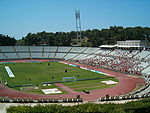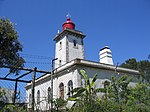Carnaxide
Carnaxide e QueijasFormer parishes of Oeiras, PortugalLisbon geography stubs
Carnaxide (Portuguese pronunciation: [kɐɾnɐˈʃidɨ]) is a former civil parish in the municipality of Oeiras, Portugal. In 2013, the parish merged into the new parish Carnaxide e Queijas. The population in 2011 was 25,911, in an area of 6.51 km². It was elevated to town on August 16, 1991. Having first appeared in official documentation in the 14th century, its existence goes back as far as 13th century.
Excerpt from the Wikipedia article Carnaxide (License: CC BY-SA 3.0, Authors).Carnaxide
Eixo Verde e Azul, Algés, Linda-a-Velha e Cruz Quebrada-Dafundo
Geographical coordinates (GPS) Address Nearby Places Show on map
Geographical coordinates (GPS)
| Latitude | Longitude |
|---|---|
| N 38.716666666667 ° | E -9.25 ° |
Address
Eixo Verde e Azul
Eixo Verde e Azul
1495-795 Algés, Linda-a-Velha e Cruz Quebrada-Dafundo
Portugal
Open on Google Maps






